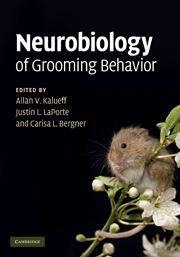Book contents
- Frontmatter
- Contents
- List of contributors
- Preface
- 1 Grooming, sequencing, and beyond: how it all began
- 2 Self-grooming as a form of olfactory communication in meadow voles and prairie voles (Microtus spp.)
- 3 Phenotyping and genetics of rodent grooming and barbering: utility for experimental neuroscience research
- 4 Social play, social grooming, and the regulation of social relationships
- 5 Grooming syntax as a sensitive measure of the effects of subchronic PCP treatment in rats
- 6 Modulatory effects of estrogens on grooming and related behaviors
- 7 Lack of barbering behavior in the phospholipase Cβ1 mutant mouse: a model animal for schizophrenia
- 8 Grooming after cerebellar, basal ganglia, and neocortical lesions
- 9 Striatal implementation of action sequences and more: grooming chains, inhibitory gating, and the relative reward effect
- 10 An ethological analysis of barbering behavior
- 11 Should there be a category: “grooming disorders?”
- 12 Neurobiology of trichotillomania
- Index
- References
9 - Striatal implementation of action sequences and more: grooming chains, inhibitory gating, and the relative reward effect
Published online by Cambridge University Press: 04 August 2010
- Frontmatter
- Contents
- List of contributors
- Preface
- 1 Grooming, sequencing, and beyond: how it all began
- 2 Self-grooming as a form of olfactory communication in meadow voles and prairie voles (Microtus spp.)
- 3 Phenotyping and genetics of rodent grooming and barbering: utility for experimental neuroscience research
- 4 Social play, social grooming, and the regulation of social relationships
- 5 Grooming syntax as a sensitive measure of the effects of subchronic PCP treatment in rats
- 6 Modulatory effects of estrogens on grooming and related behaviors
- 7 Lack of barbering behavior in the phospholipase Cβ1 mutant mouse: a model animal for schizophrenia
- 8 Grooming after cerebellar, basal ganglia, and neocortical lesions
- 9 Striatal implementation of action sequences and more: grooming chains, inhibitory gating, and the relative reward effect
- 10 An ethological analysis of barbering behavior
- 11 Should there be a category: “grooming disorders?”
- 12 Neurobiology of trichotillomania
- Index
- References
Summary
Summary
The striatum is a subcortical structure thought to be important for higher motor functions and reward processing. It is part of a larger system called the basal ganglia (BG) and composed of multiple subregions thought to be functionally heterogeneous. This review provides information and evidence for the role of the striatum in implementing the fixed action pattern of the grooming chain in the rat. The support for the involvement of the dorsolateral striatal subregion involved in the production of this movement sequence is described, and the general functional significance of implementation by striatal circuitry is discussed. Implementation is meant to refer to the ability of local processing within striatal circuits to enable motor action plans to be completed without distraction from competing sensory or motor demands. The idea that the striatum is involved in more than motor functions is developed and evidence for detailed processing of reward outcomes is presented. We introduce the possibility that the general nature of striatal function of “implementing” chains of information crosses different functional boundaries between movement and reward information. For movement plans, the implementation includes enabling motor sequences for appropriate output and for reward plans, the implementation includes enabling reward incentive hierarchies for appropriate outcome choices. These types of functions could rely upon cross-talk among striatal subregions and reveal a possible shared integrative function for the different “loops” of the BG circuitry.
- Type
- Chapter
- Information
- Neurobiology of Grooming Behavior , pp. 156 - 183Publisher: Cambridge University PressPrint publication year: 2010
References
- 2
- Cited by



